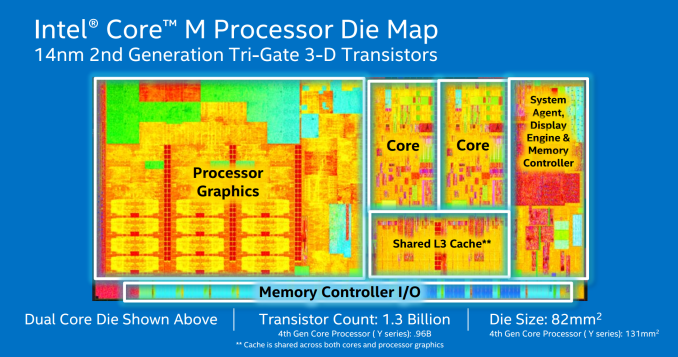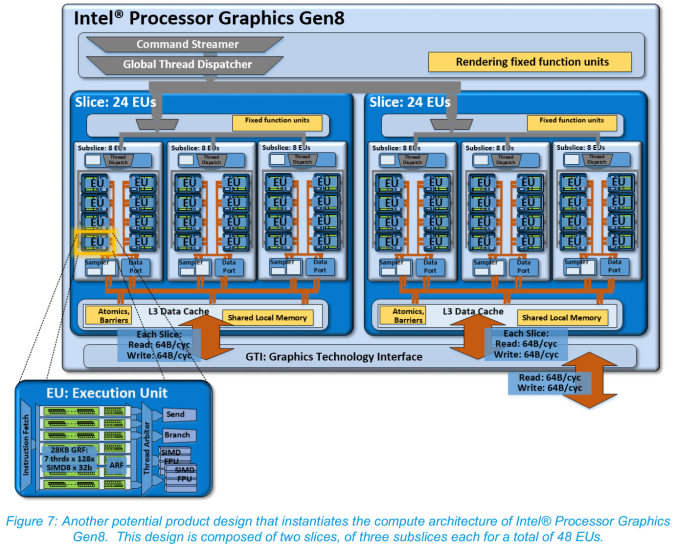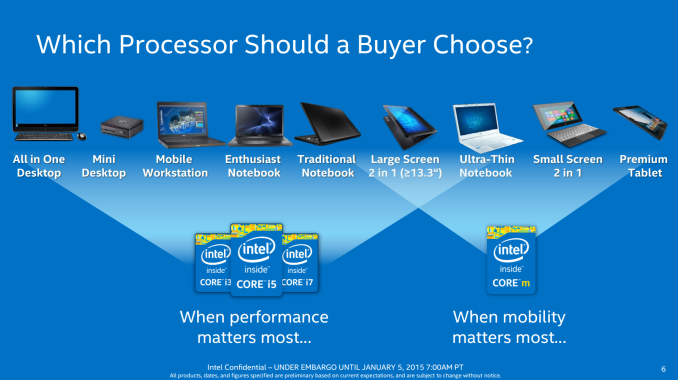Analyzing Intel Core M Performance: How 5Y10 can beat 5Y71 & the OEMs' Dilemma
by Brett Howse & Ian Cutress on April 8, 2015 8:00 AM EST
A processor architect can battle between two major opposing principles. The one most of us seem to enjoy is performance, which when taken to the extreme exhibits an all-or-nothing approach. At the other end is low-power operation which has become the main focus of the laptop and notebook market where battery capacity and density is at a premium. The position in the middle of this is efficiency, trying to extract the best of performance and power consumption and provide a product at the end of the day which attempts to satisfy both.
Of course processor architects only have control up to the point where the chips leave the fab, at which point the final product design is in the hands of OEMs, who for various reasons will have their own product design goals. It's this latter point that has resulted in an interesting situation developing around the Core M ecosystem, where due to OEM design goals we've seen the relative performance of Core M devices vary much more than usual. In our tests of some of the Core M notebooks since the beginning of the year, depending on the complexity of the test, the length of time it is running and the device it is in, we have seen cases where devices equipped with the lowest speed grades of the Core M processor are outperforming the highest speed grade processors in similar types of devices, an at-times surprising outcome to say the least.
Never content to leave things alone, we wanted to take a look at the performance in Core M in depth and how device design - particularly cooling design - can significantly impact performance. So for today we will be diving deep into Core M, to see what we can test and what can be said about system design as a whole for the mini-PC, notebook, tablet and 2-in-1 ecosystem.
Core M
First, let us loop back to the design of Core M, which historically sits in the ‘Y’ processor stack and goes by the codename Broadwell-Y. Core M only comes in dual core flavors with Hyperthreading, with an official TDP of 4.5 watts. Each model comes with 4MB of L3 cache and Intel’s 8th generation of graphics architecture under the designation HD 5300.
HD 5300 is technically a 24 execution unit design, consisting of a major slice with three sub-slices of eight execution units each. This is double the GT1 / HD (Haswell) design where Intel enables only 12 units (which has benefits when it comes to enhancing yields), or half the full GT3 implementation which keeps the same front end but doubles the major slices. A full on 48-EU design looks something like this, although Core M only has one major slice.
The three main differentiators between each of the SKUs in the Core M line are the processor base frequency, the processor turbo frequency and the integrated graphics frequency range. A number of the processors also support cTDP Up and cTDP Down modes which adjust the base frequency of the processor only. Core M supports Turbo Boost Technology 2.0 which allows individual cores of the silicon to increase in frequency within specified parameters, which may include workload, estimated current/power consumption, and temperature. These two points are key to the rest of the article.
| Core M Specifications | |||||||
| Model Number | 5Y71 | 5Y70 | 5Y51 | 5Y31 | 5Y10c | 5Y10a | 5Y10 |
| Cores/Threads | 2 Cores / 4 Threads | ||||||
| CPU Base/ Boost Frequency |
1.2 GHz 2.9 GHz |
1.1 GHz 2.6 GHz |
1.1 GHz 2.6 GHz |
0.9 GHz 2.4 GHz |
0.8 GHz 2.0 GHz |
0.8 GHz 2.0 GHz |
0.8 GHz 2.0 GHz |
| GPU Base/ Boost Frequency |
300 MHz 900 MHz |
100 MHz 850 MHz |
300 MHz 900 MHz |
300 MHz 850 MHz |
300 MHz 800 MHz |
100 MHz 800 MHz |
100 MHz 800 MHz |
| TDP | 4.5 W | 4.5 W | 4.5 W | 4.5 W | 4.5 W | 4.5 W | 4.5 W |
| cTDP Down (CPU Base) |
3.5 W 600 MHz |
No | 3.5 W 600 MHz |
3.5 W 600 MHz |
3.5 W 600 MHz |
No | No |
| cTDP Up (CPU Base) |
6.0 W 1.4 GHz |
No | 6.0 W 1.3 GHz |
6.0 W 1.1 GHz |
6.0 W 1.0 GHz |
No | No |
| Intel vPro | Yes | Yes | No | No | No | No | No |
Core vs. Atom
In general, Core M is a small departure from Intel (pun intended), bringing its main Core processor architecture, typically used for big core performance, down to power levels and chip sizes better suited for fanless laptops and tablets. Despite the drop in core counts and frequency to reach 4.5 watts, the Core M line typically has a single threaded performance advantage at this power segment as compared the competition, which is no simple achievement.
For Intel, this 4 to 5 watt TDP window for processors has typically been occupied by the Atom line of integrated SoCs. In 2014 this meant Silvermont cores in a Bay Trail system produced at the 22nm process node, but for 2015 will mean Airmont cores in a Cherry Trail system at 14nm. For most of 2014, Atom competed against high powered ARM SoCs and fit in that mini-PC/tablet to sub 10-inch 2-in-1 area either running Android, Windows RT or the full Windows 8.1 in many of the devices on the market.
Despite Intel’s initial long cadence with Atom, we are seeing them step up to the plate and provide an iterative cycle that allows for the latest node technologies combined with the updated graphics technology from the integrated Core ecosystem. Nevertheless, Intel has split this 4 to 5 watt TDP segment into two clear formats based on performance and price.
Atom sits at the lower price band ($50-$100 per chip), typically in a dual or quad core arrangement without hyperthreading and uses ‘modules’ of two discrete cores sharing an L2 cache. The integrated IO is designed to be enough for this market segment, as seen in the recently announced Surface 3, and shows that devices in the $500 region are ripe for the next Atom SoCs. Note that Braswell, which also uses Airmont cores at 14nm but goes under the Celeron/Pentium nomenclature, also sits in this 4 to 6 watt region but is aimed more at the mini-PC arena.
Intel lists all of the Core M processors at $281, and a user will be hard pressed to find a Core M device priced under $700 on the market now; such is the gap that Intel wants to strike with the two platforms. Core M sits at the heart of the new Macbook (read our hands on), as well as most of the devices in this test such as the ASUS UX305, Lenovo Yoga 3 Pro and the Dell Venue 11 Pro 7000. With the Broadwell architecture and hyperthreading under its belt, the results do speak for themselves as Core M attacks the Haswell-U line from the last 18 months in terms of direct performance.













110 Comments
View All Comments
maxxbot - Wednesday, April 8, 2015 - link
If the device buyer's choice is between the Core M and an ARM or Atom they're going to go with the Core M because it's faster in every aspect, especially burst performance. If the Core M in unacceptable slow for you then there aren't any other options at the 4.5W TDP level to turn to, it's the best currently available.name99 - Wednesday, April 8, 2015 - link
That ("Maybe Intel made too many compromises") seems like the wrong lesson.I think a better lesson is that the Clayton Christensen wheel of reincarnation has turned yet again.
There was a time more than 40 years ago when creating a computer was a demanding enough exercise that the only companies that could do it well were integrated top to bottom, forced to do everything from designing the CPU to the OS to the languages that ran on it.
The PC exploded this model as standardized interfaces allowed different vendors to supply the BIOS, the OS, the CPU, the motherboard, the storage, etc.
BUT as we push harder and harder against fundamental physics and what we want the devices to do, the abstractions of these "interfaces" start to impose serious costs. It's no longer good enough to just slap parts together and assume that the whole will work acceptably. We have seen this in mobile, with a gradual thinning out of the field there; but we're poised to see the same thing in PCs (at least in very mobile PCs which, sadly for the OEMs, is the most dynamic part of the business).
This also suggests that Apple's advantage is just going to keep climbing. Even as they use Intel chips like everyone else, they have a lot more control over the whole package, from precisely tweaked OS dynamics to exquisitely machined bodies that are that much more effective in heat dissipation. (And it gets even worse if they decide to switch to their own CPU+GPU SoC for OSX.)
It's interesting, in this context, where the higher frequency 1.2GHz part is difficult for some vendors to handle, to realize that Apple is offering a (Apple-only?) 1.3/2.9GHz option which, presumably, they believe they have embodied in a case that can handle its peak thermals and get useful work out of the extra speed boost.
HakkaH - Friday, April 10, 2015 - link
Device buyers don't even see beyond the price tag, brand name and looks. 90% of the people who buy tech are pretty oblivious on what they are buying. So they wouldn't even know if a device would throttle the speed at all.Secondly I'd rather have a device that throttles good which processors are doing the last couple of years than have a steady pace at which it just crawls along and maybe after 5 minutes decides... hey maybe I can add 200 MHz and still be okay. If that is your case I bet you still have the first generation smartphone in your pocket instead of a more recent model because they all aggressively throttle the CPU and GPU in order to keep you from throwing your phone out of your hands ;)
HP - Saturday, August 8, 2015 - link
Your description doesn't follow the usage paradigm of most computing tasks. As the user is actively using their device what they do on the machine roughly tracks the user's thought patterns which largely takes place in series. He doesn't batch the tasks in his head first and then execute them. So race to sleep is where it's at.milkod2001 - Wednesday, April 8, 2015 - link
What about Intel's native 4 core mobile CPUs. Are any in the works?Core M,Y, U(2 core) etc might be OK for bloggers, content consumers etc but if one wants/needs real performance on the go, there's not that much new to offer, right?
nathanddrews - Wednesday, April 8, 2015 - link
I think we'll have to settle for the i7-4700 until Skylake. Not a bad place to settle.kpkp - Wednesday, April 8, 2015 - link
"Atom competed against high powered ARM SoCs and fit in that mini-PC/tablet to sub 10-inch 2-in-1 area either running Android, Windows RT or the full Windows 8.1 in many of the devices on the market."Atom in Windows RT? Wasn't RT ARM only?
Essence_of_War - Wednesday, April 8, 2015 - link
Very impressed by the Zenbook, especially at its price point.boblozano - Wednesday, April 8, 2015 - link
Thanks for the detailed article.In this space it's clear that the top design consideration is cooling - do that well, and everything else follows. Performance will be delivered by the SoC's ability to turbo as needed, power consumption by the SoC and the rest of the design.
Of course materials, size, the question of passive vs. active cooling ... all that also factors decisively into the success of a design, whether the target market actually buys the devices.
But the effectiveness of the cooling will largely determine performance.
Refuge - Wednesday, April 8, 2015 - link
The efficiency of the cooling too. Can't have it take up too much space or too much power (If active and not passive)otherwise you leave either no room for your battery, or you drain it too fast keeping the thing cool (In the case of active)